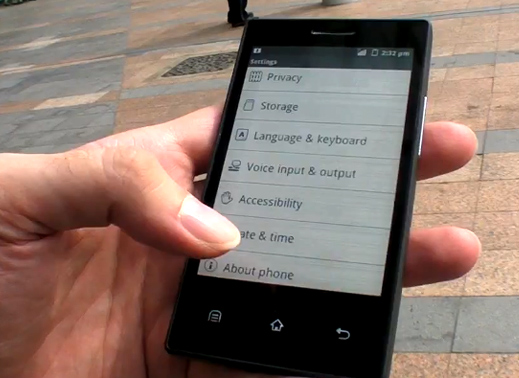E-Ink, Largely Limited to E-Readers, Appears in a Chinese Smartphone
A little known Chinese e-reader vendor, Onyx International, leapt into the tech spotlight earlier this month when it showed off a prototype Android smartphone device with an e-ink display. Soon the Web was buzzing with cheers and jeers and many as-yet-unanswered questions about the phone, and whether Onyx can overcome e-ink’s inherent limitations to meet smartphone users’ increasingly high expectations.

Onyx International is a four-year-old tech firm hailing from Guanzhou in southern China’s tech manufacturing heartland near Shenzhen and the border with Hong Kong.
Display aside, the “e-ink Phone” demoed in this YouTube video is nothing spectacular. It supports Wi-Fi and the WCDMA flavor of 3G, features an ARM Cortex-A5 processor and runs the slightly outdated Android 2.3 operating system from Google. However, the super-thin capacitive touch e-ink display makes it incredibly light—apparently less than 100 grams—and easy to read in direct sunlight. The battery life is also said to be an impressive one week, thanks to the low power consumption of the display.
E Ink Corporation was co-founded by MIT professor Joseph Jacobson in 1997, and the company has pioneered the manufacture of electrophoretic displays. These contain electronic ink made up of millions of tiny microcapsules, each filled with even smaller particles suspended in clear liquid. The capsules are either positively charged (white) or negatively charged (black), and when a voltage is applied, the corresponding particles move to the top of the microcapsule depending on the charge—therefore making the surface appear either black or white at that point on the screen.
E-Ink can be applied onto virtually any surface, including glass, plastic, fabric, and even paper. This means the display is much thinner and weighs less than a conventional LCD, making the Onyx device sleek and light, and—perhaps more importantly with a smartphone—potentially shatterproof if plastic substrates are used.
E-ink has been largely preferred to LCDs in e-readers up until now for three main reasons, according to Juniper Research senior analyst Nitin Bhas: First, the display produces no glare in direct sunlight; second, electronic paper can hold a static image indefinitely without constant refreshing; and third, because it doesn’t need to be refreshed so often, the battery lasts longer.
E-ink has been found on the always-on sub-displays of some smartphones—as in Sony Ericsson’s Urbano Affare—or as the primary display of the limited-feature Motofone E3. However, making it work in a smartphone is a different matter. E-ink is available only in monochrome at present, and display refresh rates are significantly slower than for LCD displays, putting video content and gaming out of reach.
Most analysts believe that device manufacturers like Onyx could help make e-ink more attractive on a smartphone. Gartner analyst Amy Teng says user interface tweaks could overcome some of e-ink’s limitations. “Rearranging the way of displaying images on an e-ink display can improve its screen refresh rate,” she says. “For example, keep the background unchanged except for the parts that need to change.”
Teng adds that hardware changes such as turning up the voltage could improve refresh rates, but warns there would be an inevitable trade-off with circuitry design and battery life. “These are improvements, not solutions,” she says.
E Ink’s chief marketing officer, Sriram Peruvemba, says the Android developer community is currently doing most of the optimization work, but “with some amount of pain.”
“Once Android is enabled with an ‘ePaper mode,’ we expect a lot of apps developed in Android for ePaper,” Peruvemba says. “Today we can get by with tuning the apps, but it can be done much better if there is an ePaper mode—and it is not for just speed alone.”
However, Prabanesh Nath, industry manager at analyst Frost & Sullivan, argues that the market is not big enough for Google itself to provide such customization. “With continual improvements in screen and user-interface tech, we are likely to see better technology,” Nath says. “Given the fact that mobile phones are more a lifestyle device these days, most users will be put off with [e-ink phones] due to the lack of ‘cool’ factor,” he says.
“From a cost standpoint, mobile devices including high-end smart phones have greatly reduced in price and entry-level mobile phones now have pretty advanced hardware, including the screen” Nath adds. “This Onyx device can only succeed if priced very low. I don’t expect it to be a mainstream product anytime soon.”
Keep Reading
Most Popular
Large language models can do jaw-dropping things. But nobody knows exactly why.
And that's a problem. Figuring it out is one of the biggest scientific puzzles of our time and a crucial step towards controlling more powerful future models.
How scientists traced a mysterious covid case back to six toilets
When wastewater surveillance turns into a hunt for a single infected individual, the ethics get tricky.
The problem with plug-in hybrids? Their drivers.
Plug-in hybrids are often sold as a transition to EVs, but new data from Europe shows we’re still underestimating the emissions they produce.
Google DeepMind’s new generative model makes Super Mario–like games from scratch
Genie learns how to control games by watching hours and hours of video. It could help train next-gen robots too.
Stay connected
Get the latest updates from
MIT Technology Review
Discover special offers, top stories, upcoming events, and more.